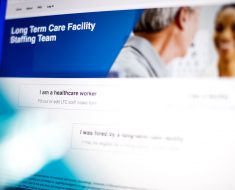Here’s what expectant parents can do to protect themselves.

In the United States, a woman’s chances of dying during or after pregnancy are higher than in any other developed nation — and they have been steadily getting worse.
The Centers for Disease Control and Prevention (CDC) puts the ratio at 18 maternal deaths for every 100,000 births.
Meanwhile, in Canada the rate is 7 maternal deaths for every 100,000 live births.
These statistics are especially frustrating since approximately 60 percent of maternal deaths in the United States are preventable, as reported by the CDC.
While the United States overall has been grappling with high maternal death rates, there is one state that has been able to reverse the trend: California.
How California is helping protect new moms
California is among the states leading the effort to decrease the number of maternal deaths.
According to the California Pregnancy-Associated Mortality Review (CA-PAMR), in 2006 there were 16.9 maternal deaths for every 100,000 live births in California — above the then U.S. average of 13.3. Now, California is on a par with Canada: 7.3 deaths for every 100,000 live births — a 55 percent reduction.
In the United States, the leading causes of maternal death include hemorrhage, preeclampsia and infection, and chronic health conditions, like heart disease and mental health issues — all of which may be treatable, said Michael Kramer, PhD, professor at Emory University.
“It means the high maternal mortality rate in this country can be changed and there are things that we can do,” Kramer said. “The question is, what are those things?”
California has instituted multiple policies to address these common dangers for pregnant women, and as a result it has one of the lowest maternal death rates in the country.
“Starting in 2006, we started working with the state to do a deep dive into the question: ‘Why are women dying?’” explained Cathie Markow, administrative director at the California Maternal Quality Care Collaborative, which coordinates the state’s efforts on maternal healthcare.
CMQCC has four main areas of focus:
- a data center that collects and makes available near-real-time metrics from hospitals and providers across the state
- toolkits that standardize responses to emergencies that may arise during or after birth
- 18 months of training for hospital staff with a specialist
- care collaboratives between hospitals and professional and community organizations
California wants other states to copy their example, and it reflects a shift in attitudes to maternity care more broadly, said Dr. Elizabeth Howell, professor at Icahn School of Medicine at Mount Sinai in New York. The American College of Obstetrics and Gynecology has released similar guidelines, or “bundles,” for hemorrhage and other medical emergencies.
“There is a big national effort to improve care in hospitals,” said Howell.
Dr. Dana Gossett, professor of obstetrics and gynecology at University of California, San Francisco, said that having a playbook is key to safeguarding patient health.
“We know that for high-risk procedures and emergent procedures, having a playbook that everyone understands, where every person in the room knows what their role is, and knows that the equipment is immediately available, the medications are immediately available, makes an enormous difference,” Gossett told Healthline.
What expectant parents should ask their doctors
To find out if a hospital follows best-practice guidelines, expectant parents can look at whether the hospital has a commitment to maternal health.
“If you were looking around and you have a choice of hospitals, and there was one hospital that was really being very proactive about coming up with and addressing issues around the quality of obstetric care and care management, that would be a good thing,” Kramer said.
Some hospitals offer tours for expectant parents, said Gossett. Seeing how well the doctors and nurses seem to communicate with one another can give a sense of how well the maternity team works as a unit.
Also important is self-education — and self-knowledge. There are things women can ask their healthcare providers when they’re picking a hospital for delivery. And there may be things that women can do to safeguard their long-term health.
Maternal morbidity rates, cesarean section rates, and other data can offer a starting point for talking to your doctor, said Howell. Some states, including California and New York, as well as individual hospitals themselves offer these metrics online.
Why you need to ask about cesarean sections even if you don’t want one
Cesarean section is not only a good starting point for enquiries — it can offer some women an opportunity to reduce their risks of complications, said Gossett. “We know that one of the biggest drivers of maternal morbidity and mortality is cesarean,” she said.
Cesarean section, also called a cesarean delivery or C-section, is medically necessary for some women. However, low-risk women who don’t need this procedure, or who elect to have one as a matter of preference, should talk to their doctors about their philosophy on cesarean first, said Gossett.
Ultimately, cesarean sections “on demand” should be avoided, she said.
Women can ask physicians what their individual rate of cesarean section is, and whether or not they know how to perform external cephalic version — essentially a process to turn the baby if it’s breached — and delivery by forceps or vacuum.
These alternative procedures can reduce the need for cesarean in some circumstances, but not every physician necessarily knows how to do them, Gossett said.
Having one cesarean section raises a woman’s chances of all her subsequent pregnancies also being delivered by cesarean section.
“C-section is major surgery which brings greater complications,” said Markow. “It may not be the first one that causes problems, but if you are planning on having multiple children, then it is really down the road where [the risk] starts to go up.”
Women can also ask their hospital if they do VBAC, which stands for “vaginal birth after cesarean.” However, not every hospital has the capacity to do it, said Gossett.
Just being aware of these risks and asking questions can go a long way to helping women make the right choices for them, said Markow.
If women are unsure about talking to their doctor or midwife, there are other resources women can turn to. Howell and Gossett recommended talking to friends and family about their experiences.
Online childbirth classes can give a good overview of what to expect from labor and after birth, said Gossett. However, if you aren’t comfortable with talking to your physician, you might want to consider getting a different one, she added.
Two areas that California is still trying to address also highlight why looking to resources outside of the healthcare system can be important for women’s safety too.
Helping women during the ‘fourth trimester’
California’s innovations concentrate on the immediate period before and after birth, when a woman is in a hospital. The CMQCC is working on a review to help address issues that can affect women after birth during the so-called fourth trimester, like postpartum depression, said Markow, but it’s still an area that needs more work.
Some strategies that Gossett recommended for women who are postpartum include finding out if local doctors or community centers offer breastfeeding clinics and other post-birth care, and knowing what your employer’s and state’s policies are on maternity leave and provisions for breast pumping at work.
Accepting help from friends and family, as well as community organizations, can make an enormous difference in women’s health and well-being after birth, said Gossett. Even simple steps like making large batches of food while pregnant and freezing it to eat when you have a tough day after birth can make a difference.
Another big issue that California is still trying to tackle is race disparity in medical treatment. While California has seen the maternal mortality rate drop, the gap between white and black women persists, said Markow.
Nationwide, black women face 40 deaths for every 100,000 births.
Howell, whose research focuses on racial disparities in maternal healthcare, said that there are things all women can do to make themselves safer.
The first is making sure that you’re healthy before you become pregnant and that your healthcare team knows about any chronic health conditions you may have before you go into hospital.
The other — more crucial — component is being able to advocate for yourself: “Information is power.”
“If you are not understanding the information the physician is giving you or they did a poor job of explaining, you ask again,” she said. “You want information as early as you can in your pregnancy, and so you just have to ask.”
related stories





Source: Read Full Article





